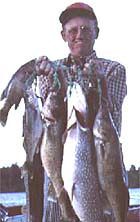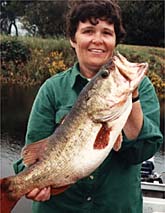|
|

|
 |
 | ||
How To Fish Deep Water
One of the best ways to fish deep water is to use wire line on the troll to reach the deeper areas of structure. There are three basic weighted lines to get lures to extra depths: lead core line, multi-stranded wire, and solid (single strand) wire. The single strand is the most desirable, gives good depth control, and is relatively easy to use after some experience is gained. A hundred yards of wire is normally all that’s needed on a reel. This amount doesn’t normally fill the reel, therefore a "backing should be used under the wire. The backing should be a good trolling monofilament, such as NO-BO Trolling Line. If and when all the wire runs off the reel, the fisherman is still in business. Quite often some wire will be lost, and the nylon trolling line can be used along with the wire in trolling. In most fishing, two wire tests will handle most situations. For the majority of fishing situations a 17 lb. test wire is sufficient (and is recommended). Where numerous "hangs" (rocks, bushes, etc.) exist use 20 lb. test wire. To obtain proper control, it is important that the trolling wire be properly rigged.  The above diagram is a sketch, showing how trolling wire should be rigged. The leader should be a good quality monofilament. The test (strength) should be approximately the same as the wire being used. The length of the leader should be the length (or distance) from the front of the reel (level wind) to the tip of the trolling rod. During hard use some of this leader will be lost (frayed, etc.), and when it gets down to about two feet in length, it should be replaced with a new leader. A small barrel swivel should be used to connect the wire line and the monofilament leader. A #10 swivel will normally move down through the rod guides (a must). A plain #2or a #3 snap should be used at the end of the leader for attaching (or changing) lures. A good guideline to follow (especially when using Spoonplugs) is the wire will obtain double the depth attained with monofilament line. For example, if a medium length wire (30-40 yds) is run with a #200 series Spoonplug, the lure should reach 18 to 24 feet in depth. The normal running depth of this size lure with monofilament is 9-12 feet. If a long to extra length wire (60-70 yds) is run, it should reach bottom at close to 30 feet. How full or how empty the reel spool (with wire) will determine to some extent just how accurate your depth control will be with each size lure. Therefore, it becomes necessary for the fisherman (through practice) to determine the EXACT amount of line to reach a specific spot or depth with a particular size lure. When letting out line count the "layers" of wire on the reel spool as the line is being released. This is done by counting the traverses back and forth as the level wind guide swings from left to right (or vice versa). This is considered one layer of wire. In counting, it is easier to count the number of layers by noting the return of the level wind guide to the original position (2 layers of wire). The count will go 2, 4, 6, 8, etc.
An important thing to keep in mind when trolling wire, is don’t have too much line out. Use the least amount of line necessary to keep your lure (Spoonplug) gently bumping on bottom. If too much line is released behind the boat, control is lost, as well as lures due to hangs. The line can be let out at a fairly good speed (of the boat).Be sure to maintain a light "thumbing" of the reel as the wire peels off. This limits any "blooming", loose lines, etc. In most all cases, when working deep water the "bottom" is our guide. We want the lure on, or as close to the bottom as possible. We want JUST ENOUGH wire let out to reach the desired depths (or bottom). For instance, let’s say you desire to hit a particular spot at 23 feet. A lure (Spoonplug) is chosen that normally runs 12 to 14 feet deep with monofilament line (a #100 or #200 Spoonplug, for example). Fourteen (14) to sixteen (16) layers of wire are released at a fairly fast clip of the boat. When the wire length is out, the boat is slowed to a crawl. The extremely slow forward motion (of the boat) is maintained until the line sinks and the lure makes contact with the bottom. At the first bump, the throttle is advanced to a trolling speed. This gives the exact desired amount of wire in the water. Do not stop the boat completely in order to allow the lure and line to sink. If the boat is stopped, it is not likely the correct length of line (for the depth being worked) is released. Usually a few seconds wait with the slow crawl is all that is needed to have the lure and line down correctly. Slight adjustments of line length can be made if the situation calls for it. Never worry regarding "feel" while running long or extra long lengths of wire. Regardless of the amount of wire in the water, the feel is still there and every little bump or wiggle can be felt. A striking fish can jar the bone. A word of caution: when the lure ''hangs'' do not attempt to throw back loose wire in order to free the lure. Loose wire in the air can create a "kink'", and subsequent pressure may cause the line to break. When handled right, wire line will last a long time. Any breakage should occur in the monofilament leader. At times, all who motor troll should practice securing depth control with wire. With practice, greater and more exact depth control can be had with wire than with monofilament. Many times extra depths will be required with a short line (such as running a tall weedline, or when following a crooked shoreline). With wire, a minimum length of line can be used to reach deeper depths with smaller lures. The use of wire line on the troll opens up a completely new ball game as far as fishing is concerned. Deep clear lakes will present fewer problems, and cold fronts will create less fear. However, let me repeat what has been stated in an earlier session. When we move into deeper water, our presentation (both casting and trolling) should be "pinpointed." In deeper water we must concentrate our efforts exactly where the fish will be. If this is not done, it is not likely our lure presentation will be exact enough to make contact. However, if we have a specific "spot'" we are shooting for, proper control is not overly difficult to obtain. This is where your knowledge of mapping, interpretation, and presentation of lures becomes important. We can assume that when the fish are shallower than 20 feet (when deeper water is available), lure presentation does not have to be quite so exact. But, when the fish are deeper (somewhere in the sanctuary depths), our interpretations and presentations must be exact. The deeper we go the more exact (and difficult) it becomes to find and catch fish. If you and I can't interpret the exact spot where the fish will be, or if we are unable to control the depth and speed of our lures at that spot, we have no business spending much time in deep water. It would be a far wiser to wait for the fish to come to us. However, in time, with practice, control can be had in the deeper water. ####
An America Outdoors Feature. All Rights Reserved. |
|
|
| Site design by Outdoor Management Network Inc. Copyright © 1996 - 2007 Outdoor Management Network Inc. America Outdoors® is a registered trademark of Outdoor Management Network Inc. |
 If a fisherman is fishing correctly and catching no fish, he is probably not fishing deep enough. However, fishing deep can be
difficult and requires precise presentation of lures or baits. A
fisherman must be on structure to effectively fish deep water.
If a fisherman is fishing correctly and catching no fish, he is probably not fishing deep enough. However, fishing deep can be
difficult and requires precise presentation of lures or baits. A
fisherman must be on structure to effectively fish deep water. Fourteen (14) to sixteen (16) layers should provide a medium
to long line . Twenty-two (22) to twenty-four (24) layers of wire
should give a long extra long line.
Fourteen (14) to sixteen (16) layers should provide a medium
to long line . Twenty-two (22) to twenty-four (24) layers of wire
should give a long extra long line.